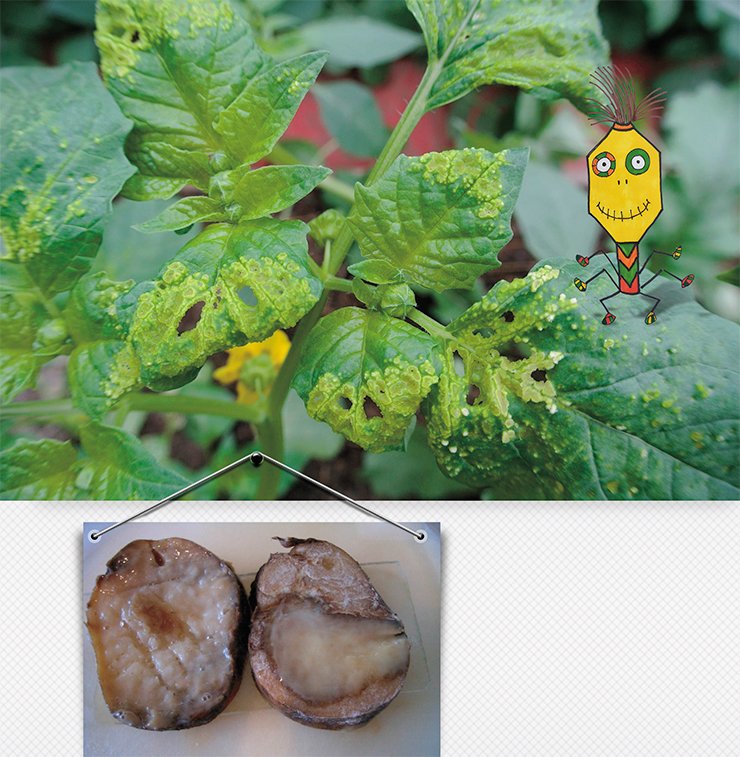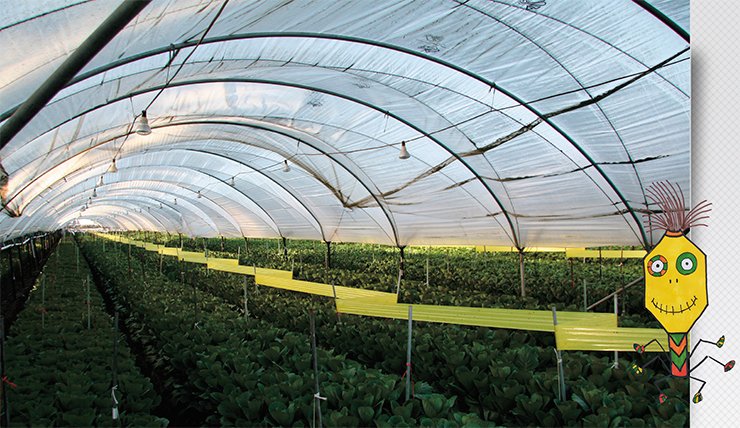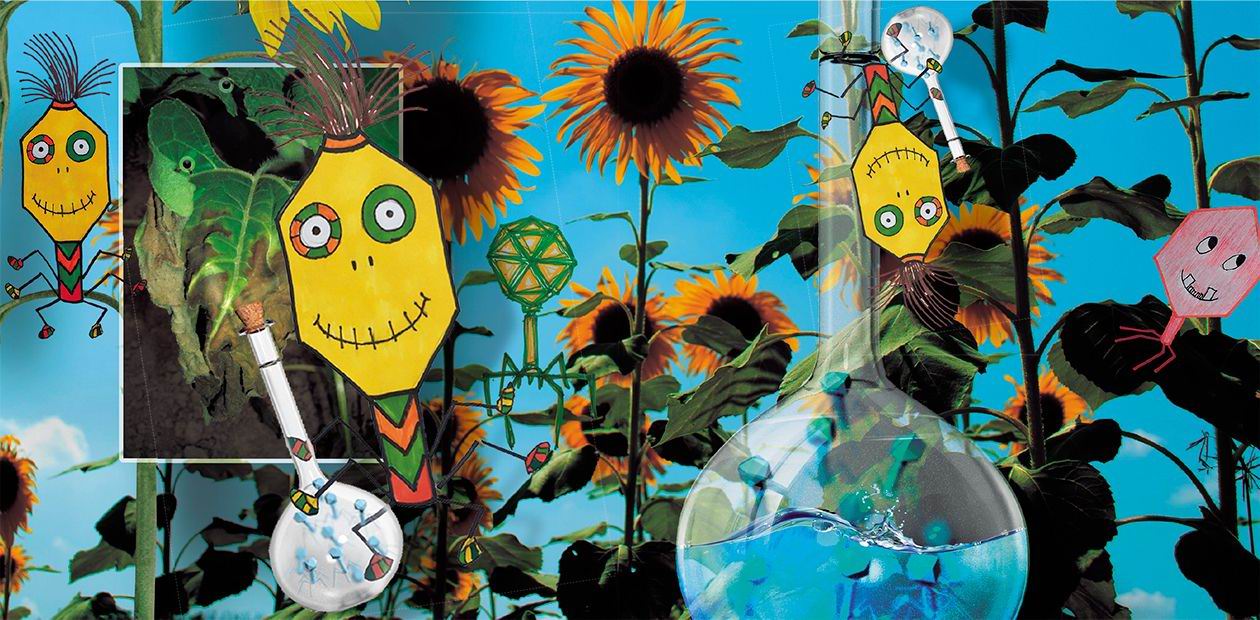Phages in Your Garden
Problems and prospects of bacteriophage applications in horticulture
Bacterial encounters are often a disaster for a plant, leading to tissue degradation and damage to the root and vascular systems. Even when bacteriosis does not immediately kill a plant, it slows down its development, reducing the size and vendibility of the crops. Phytopathogenic bacteria have been long and rather successfully controlled by using special agricultural products, which were, as a rule, crude and cheap versions of medical antibiotics of the streptomycin and tetracycline series. However, this path may have dangerous and unpredictable consequences both for the global environment and human health
Phytopathogenic bacteria cause extensive damage to global agriculture. Fighting these infections is always a challenge. As a rule, agriculturally important plants are cultivated on large land plots, and individual monitoring and treatment of each plant is very time-consuming and expensive, if at all possible. Weeds, pest insects and fungi are controlled through the mass use of herbicides, pesticides and fungicides.
In the last decade, the international medical community has been alarmed by the rapid spread of varieties (strains) of pathogenic bacteria resistant to several classes of antibiotics used in clinical practice. The infections caused by these bacteria lead to most severe complications and impede the treatment of diseases, leading to thousands of deaths and huge economic losses.
Importantly, the greatest danger is associated with nosocomial infections, which are caused by strains circulating in hospitals. Constantly exposed to pressure resulting from the use of antimicrobial agents, these bacteria have adapted to these agents and acquired multiple resistance to antibiotics.

The likelihood of catching such an antibiotic resistant infection in everyday life is, as of today, relatively low because medical antibiotics affect environment only in the places of their permanent use. However, this “setback” is by far compensated by agricultural antibiotics: industrial farmers worldwide use them on a scale of tens of thousands of tons every year to combat bacterial diseases in animals and plants. It is the excessive use of agricultural antimicrobials that is the most likely culprit for the mass development of opportunistic pathogenic bacteria, which are common in nature and do not pose any particular risk for human health, but can affect people with a weakened immune system. However, it is virtually impossible to get rid of those “opportunists” because of their resistance to antibiotics.
Therefore, legislative measures to restrict the use of antibiotics in agriculture, especially for preventive rather than curative purposes, is a very smart move in terms of global health. In light of this situation, organic horticulture, which is focused on the maximum diversity and productivity of plants with the minimum use of xenobiotics, becomes a rational response to the current challenges rather than a fashionable trend.
On the road to organic horticulture
Organic horticulture is not at all about those next-to-idiotic concepts saying, “Yes, we grow small and stunted vegs and in medieval quantities, but we grow them on the dung and remove all the worms by hand.” It is a harmonious blend of modern achievements of agricultural science—new resistant and productive varieties, modern mechanized farming technologies, calculated use of a combination of organic and inorganic fertilizers, monitoring crop sizes and plant diseases, modern storage and processing technologies, etc. This mix also includes science-based tailored applications of biological control agents.
We define biological control as the use of living organisms, i. e., specific predators or parasites, to suppress pest populations in agricultural areas. In particular, an appealing strategy to combat bacterial infections in plants is the use of bacteriophages, or bacterial viruses targeting specific pathogens. This concept has many advantages. Phages are natural inhabitants of the same ecological niches as bacteria; hence, their use does not affect the state of major ecological systems. Phage breeding technologies and applications are logical, relatively simple and inexpensive. Agricultural phage therapy can be combined with most other chemical and biological control methods and is safe both for the treated plants and for humans and animals.
However, it should be understood that phage phytocontrol is not a panacea against plant pathogens. Successful development of any phage therapy, including in plants, requires detailed understanding of the biology and genomics of bacteriophages and target organisms, research efforts to explore their interactions, and technologies of selective breeding of targeted phages. At first glance, this method is so hi-tech that it is intimidating. But are these fears realistic and what are the prospects for agricultural phage therapy?
How it all began
It all began at the beginning of the twentieth century, when Félix d’Hérelle proposed his theory of infectious lysis of bacteria by viruses. As the awareness and acceptance of this theory was growing among researchers, global enthusiasm about the potential of bacteriophages was growing. After all, it was a time before the discovery as well and mass use of antibiotics, which became later the gold standard in the treatment of bacterial infections. In the 1920s–1930s, there were virtually no effective methods to control diseases caused by bacteria. No wonder that one immediately began testing phages as therapeutic agents for the treatment of virtually all known diseases of microbiological origin.
The earliest documented experiments to control and treat bacterial diseases in plants were conducted at the University of Michigan (USA). In 1924, Mallmann and Hemstreet showed that the filtrate of cabbage tissue affected by Xanthomonas campestris can inhibit growth of the pathogen under laboratory conditions. The following year, Kotila and Coons showed that phages with specific activity against the causative agent of blackleg disease in potatoes can be isolated directly from soil. When the bacteriophage and the pathogen, i. e., the bacterium Erwinia carotovora (its modern name is Pectobacterium carotovorum subsp. carotovorum), were simultaneously applied to potato tubers and carrot roots, rotting was observed only in those samples where there was no phage.
In 1934, the English researcher Robert Massey gave an explanation of the intriguing fact that the incidence and severity of bacterial blight disease in field-grown cotton, which is caused by the bacterium Xanthomonas malvacearum, was lower on lands that were flooded by waters of the Nile River. He suggested that a key factor in limiting the severity of the disease was the phages transported by river waters. The following year, he proved his hypothesis by showing that phages were found only in the soil of the areas that had experienced floods.
Despite these results, the early works provided little understanding of how bacteriophages work in natural conditions, and the number of failed phage therapy attempts far exceeded that of successful ones. At that time, there was an apparent lack of information on how to select, characterize, cultivate and use bacteriophages in medicine and in agriculture.
A trigger for a new round of interest in bacteriophages, which occurred in the 1960s–1970s, was the discovery that these microscopic organisms can be conveniently manipulated. Bacteriophages helped discover and describe many of the fundamental processes that are now the classics of molecular biology. However, there was much less attention to practical applications of phages, which is not surprising given the total domination of antibiotics in the treatment of bacterial infections in human and veterinary medicine and in horticulture.

The majority of these experiments were conducted in Japan, a country that did not participate in the first stage of phage research. Although the scientific press of that time contains a number of successful reports on phage therapy, including in agriculture, the attempts to summarize the data and develop a framework concept were unsuccessful. Moreover, some researchers even wondered how one could have obtained any repeatable positive results at all. In the context of the widespread introduction of antibiotics and other chemical agents (e. g., copper compounds) in agriculture, using phages to treat plant diseases looked as an exceedingly complicated and unpromising alternative.
Since then, despite the increase in information about the structure, genetics and action mechanisms of bacteriophages, the interest in phage applications for the treatment of bacterial diseases of plants has remained stably low. Every year, microbiological and agricultural journals publish a few papers about successful cases of phage therapy of a given plant–pathogen combination, propose a phage preparation, which is sometimes even patented and produced commercially (e. g., Multifag in Belarus and Pentafag-C in Ukraine). However, the response to these publications and the commercial success of the products is low because many of the logical questions posed by skeptics still remain unanswered.
The five cons
There is a number of fundamental limitations arising from the biology of the interaction between a virus and its host, which complicate the use of phage therapy and serve as a basis for criticism of varying degrees of validity.
The major limitation of bacteriophages is their high infectious specialization with respect to host bacteria. Each type (clone, or race) of bacteriophages infects a fairly narrow group of strains within a taxonomic species of bacteria. The choice depends on the bacterium’s receptor molecule to which the virus attaches itself, on the adaptation to the metabolic cycle of the host bacteria, and on other factors. Phages that are able to parasitize bacteria of different species or genera are extremely rare, and the bacteria infectable by these phages are, as a rule, closely related.
The narrow spectrum of the infectious action of phages presents a fundamental contrast to the broad spectrum of antibiotics. There is a well-founded opinion that if the causative agent is not clearly identified, the phage is likely to fail. Therefore, an extremely important step in phage therapy is a highly accurate diagnosis of the pathogen (up to a strain group). Given that plants can demonstrate similar symptoms when infected with different microbiological agents and that agricultural diagnostics is much less developed in comparison with medical diagnostics, this requirement is often considered as a critical limitation.
The next limitation is the rapid adaptability of bacterial pathogens. Opponents of phage therapy always point out that bacteria can mutate and become resistant to individual phages. Indeed, the classical experiments conducted by Luria and Delbrück showed that the probability of a phage resistant mutation is about 10–9. That is, any large bacterial population will soon produce a mutant uninfectable with the phage. Therefore, the use of bacteriophages in a large ecological system will at best slow down the progression of a disease rather than stop it completely.
Another factor that cannot be ignored is the complexity of microbial communities. Apart from the above mentioned ability of different bacteria to cause diseases with similar symptoms, the infection may likely involve several strain groups of the same or similar pathogens. Many phytopathogens have not yet been studied by modern methods, and there are cases where bacteria with the same set of morphological and biochemical properties are found to be quite different genetically.
An example is the bacterium Xanthomonas campestris pv Vesicatoria, which causes bacterial leaf spot (BLS) on tomatoes and peppers. This bacterium, which was previously considered a separate species, is in fact a mix of at least four different species, each of which contributes to the development and manifestation of BLS symptoms. The high specialization of bacteriophages will likely render useless any phage applications against such uncharacterized microorganisms.
It is generally accepted that a key requirement for successful phage therapy is a high concentration of the phage. Indeed, for phage control to be effective, phages should be present in an amount exceeding a certain threshold relative to the target bacteria (multiplicity of infection). Most publications give numbers of 106–108 particles per ml, depending on the density of bacterial population. At concentrations below this threshold, the therapeutic effect will be insignificant. However, the production of high-concentration bacteriophage preparations to spray fields will most likely be economically unfeasible.
Moreover, regardless of the concentration ratio between the phage and the bacterium, phage therapy will not succeed unless the target microorganism is physically available to the phage. Environmental microbiologists use the term spatial refuge for the primary means by which a microorganism avoids an attack. Bacterial populations on the plant surface (phyllosphere) and in the soil layer adjacent to the roots (rhizosphere) are very heterogeneous in terms of density and are physically mobile. Viruses, however, cannot move on their own; therefore, their penetration into the plant tissues is a challenge even for preparations with a high bacteriophage concentration.
The vulnerability of phage particles deserves special attention. Field and laboratory studies have shown that viruses become inactive at high temperatures, at high and low acidity, when exposed to solar radiation, and in a medium with insufficient or excessive humidity. Thus, the conditions that are natural for the phyllosphere are detrimental to phages, leading to a strong and rapid decrease in the bacteriophage population on the treated plant. Introducing bacteriophages into the soil extends their circulation period, which may reach a few days, and the small size of the phages allows them to penetrate, together with the flow of fluid, directly into the vascular system of plants.
However, if the phage does not find the target bacterium to multiply, its lifetime in the colloidal solution will be limited. Although bacteriophage particles are completely biodegradable and do not accumulate in the environment, like inactive antibiotics and chemical protection products, the short period of existence (persistence) of phages on the plant surface and in the soil under natural conditions is a prime factor that virtually eliminates the possibility of their preventive use.
These are, of course, objective challenges. But are they really so insurmountable as is believed by phage opponents? As a rule, each of these problems has a solution.
Problems solved
The narrowness of phages’ infectious spectrum can be addressed by pre-screening, i.e., selective breeding of phages with a wider action spectrum or finding a combination of several phages to cover the most likely infectious range of the pathogen or the set of pathogens. This approach is used in the design of medical phage drugs, both those that have been produced for years in Russia and Georgia and those recently launched in a number of countries around the world. Some of these preparations include 30–40 different bacteriophages to target as many bacteria as possible.
However, there is a downside to this solution: combining a large number of different phages in high concentrations in one preparation may lead to interactions (aggregation, nonspecific adsorption, and unspecific recombination) between the phages. According to many researchers involved in the design of phage compositions, the optimal number of different bacteriophages in one preparation is 5 to 10 strains.
Designing phage products that combine several viruses infecting the same pathogen is an important step to address bacterial resistance to bacteriophages. There is now a good understanding of how bacteria develop this resistance; it is even possible to perform artificial selection of phages against bacteria that emerged as a result of the most likely mutations.
For example, let us assume that the fastest and most effective defensive solution for a bacterium is to discard or alter the receptor to which the bacteriophage attaches itself. These receptors are different molecules on the surface of bacteria: the proteins of pili (hair-like appendages for bacterial conjugation) and transport channels, surface polysaccharides and peptidoglycans, etc. Excluding these molecules from the metabolism of the bacterial cell often has a strong impact on its viability: there is extensive evidence that phage-resistant mutants of pathogenic bacteria are less aggressive and the host microorganism can better cope with them. If a preparation contains several phages that attach to different receptors, then this combination will, first, reduce the probability of a mutant resistant to all phages and, second, the resulting mutant will be even less pathogenic.
In the press, you may come across publications about horticultural applications of phage lysins, i. e., phage enzyme proteins that destroy bacterial cells. But these results look more like a ridiculous story than serious science: the undisputed limiting factor is the high cost of recombinant proteins and the need for point-like application of the products. Even if a particular enzyme product has proved effective for a few indoor plants, it is difficult to imagine a person walking with a brush across an endless potato or corn field in search of spots infected by bacterial pathogensGiven the tremendous diversity of microorganisms in nature, the number of bacteria and their strains with significant pathogenic effect on plants is large yet limited. Modern molecular diagnostics (PCR and immunochemical methods) can already—or will soon be able to—detect most of these pathogens. Although more expensive, this diagnostics is faster and more accurate, compared with conventional microbiological methods. Therefore, it could be a viable solution for large-scale agricultural businesses to conduct regular microbiological monitoring and set up their own diagnostic laboratories.
The task of choosing a panel of bacteriophages capable of infecting phytopathogens that are most common in certain cultures in a particular locality is huge yet not infinite. In recent years, a new term has come into use: personalized medicine, which includes, inter alia, personalized selection of drugs based on the causative agent of the disease and the patient’s condition.
In horticulture, it is virtually impossible to diagnose and treat each plant. However, when it comes to the treatment of large plots in one locality with one plant culture coming from a single seed source, then the organization of diagnostic monitoring followed by the selection and production of a phage preparation adapted to a specific pathogen is a realistic action plan fitting into the concept of high-tech agriculture.
Recently, smart solutions have emerged for how to maintain the necessary concentrations of phage-therapeutic agents and increase the time span of phage preparations. A well-known method of biological control and soil bioremediation in horticulture is the use of non-pathogenic bacteria belonging, as a rule, to the Bacillus, Agrobacterium, Rhizobacterium and Pseudomonas genera. When introduced into the soil, they act as antagonists of pathogenic microorganisms, preventing their reproduction and the transfer of infection on plants. This approach also has some fundamental limitations, but it has been quite successful in agriculture.
With the increase in our knowledge about the biology of bacteriophages, it was found that some of these bacteria may act as intermediate hosts for phages that are active against their close pathogenic relatives. The lytic activity of these phages is considerably lower, but when they are introduced into the rhizosphere together with the bacterial antagonists, their concentration will longer remain at a stable level than when phages are put there alone.
For example, certain strains of the bacterium Pantoea agglomerans, which serve as antagonists of Erwinia amylovora, a fruit-tree pathogen, may act as an intermediate reservoir for phages that are highly infectious towards this bacterium. The effect of this combination product was comparable with that of streptomycin (Balogh et al., 2010). Another study described a successful use of a nonaggressive strain of Ralstonia as an intermediate host for a phage active against the solanaceous pathogen R. solanacearum (Fujiwara et al., 2011). A further development of this approach may be the selection of phages that can multiply at a low rate in bacteria belonging to the normal soil flora.
To simplify and reduce the cost of applications, both bacteriophages and bacterial antagonists are typically used in the form of culture solutions. However, this approach makes it difficult to ensure the necessary concentration and viability of active agents during the storage of the phage preparation.
Recently, new technologically advanced and cost-effective methods have appeared whereby populations of bacteria and bacteriophages are confined in polymer capsules. This method stabilizes the biological product and ensures its gradual release into the rhizosphere. The treatment of seeds with these encapsulated products provides protection against pathogens in the early stages of plant development.

To implement phage control of plant diseases in modern agriculture, it is very important to have a clear understanding in what agronomic situations bacteriophages are the most effective. Phage therapy is most successful in closed biological systems with controllable physical conditions. It is almost impossible to achieve these ideal conditions on large agricultural fields; however, this does not mean that phage products cannot be effective there as well.
Today, an increasingly popular technology in commercial agriculture, especially, in the production of seeds, is greenhouse horticulture with fixed-composition substrates, drip irrigation and hydroponics. In these cases, the use of phage preparations against timely and accurately diagnosed pathogenic bacteria that cause plant diseases is fully justified and has a high chance of success.
Summarizing all the above, it can be argued that there are no fundamental obstacles to introducing bacteriophages for control and treatment of bacterial diseases in industrial horticulture. However, it is necessary to take some technological and methodological measures to make this promising approach an integral part of organic agricultural technologies.
References
Balogh B., Jones J. B., Iriarte F. B. et al. Phage therapy for plant disease control // Cur. Pharmac. Biotechnol. 2010. V. 11(1). P. 48—57.
Fujiwara A. et al. Biocontrol of Ralstonia solanacearum by treatment with lytic bacteriophages // App. and Envir. Microbiol. 2011. V. 77. P. 4155—4162.
Gill J. J., Hyman, P. Phage choice, isolation, and preparation for phage therapy // Cur. Pharmac. Biotechnol. 2010. V. 11(1). P. 2—14.
Goodridge L. D. Bacteriophage biocontrol of plant pathogens: Fact or fiction? // Trends in Biotechnol. 2004. V. 22(8). P. 384—385.
Jones J. B., et al. Bacteriophages for plant disease control // Ann. Rev. of Phytopathol. 2007. V. 45. P. 245—262.
This publication uses photos by A.N. Ignatov (All-Russian Research Institute of Phytopathology, Moscow oblast) and drawings by Zhenya Vlasov









